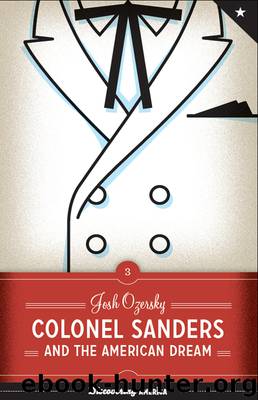Colonel Sanders and the American Dream by Josh Ozersky

Author:Josh Ozersky
Language: eng
Format: epub
Publisher: University of Texas Press
Published: 2012-11-26T16:00:00+00:00
4
BARBARIANS AT THE GATE
By 1969, five years after the sale, the average Kentucky Fried Chicken restaurant had annual gross sales of nearly a quarter of a million dollars. Many were double that. The stock price at its highest was more than fifty-five dollars—an astronomical sum by the standards of the time. More than three thousand stores were in the system, with more opening every week. The company passed Howard Johnson as the leading food dispenser in America, excluding only the Army, the Navy, and the U.S. Department of Agriculture’s school lunch program. These were inspiring numbers and, one would have thought, more than enough to keep Brown and his troops busy. The company was still a small one, with most of the major decisions being made by Brown and his immediate subordinates (usually including a courtesy consultation with the Living Legend) in their Nashville headquarters. The stock price was based on the rate of expansion that Kentucky Fried Chicken had seen in the 1960s, when the country was virgin territory and such rivals as Kentucky Fried Chicken found were small, poorly organized, and late to the game.
No entity as singularly and spectacularly successful as Kentucky Fried Chicken could fail to inspire imitators. Much as the novel success of White Castle earlier in the century inspired a nationwide wave of clones with variant DNA—White Tower, Blue Castle, Royal Castle, White Manna, White Diamond—Kentucky Fried Chicken inspired a flurry of get-rich-quick schemes looking to cash in on the fried-chicken craze. There was All-Pro Chicken, Chicken Hut, Maryland Fried Chicken, Ozark Fried Chicken with “Miss Alma’s Recipe,” Cock-A-Doodle of America, Pail-O-Chicken, and Wife-Saver Chicken. Various celebrities, too, were encouraged by their accountants to lend their names to chicken chains in the hope that a ready-made icon might rival the Colonel’s all-powerful brand recognition. Country music proved to be a profitable breeding ground for these chains: Grand Ole Opry superstar Minnie Pearl and crooner Eddy Arnold sold their share of birds, and later, when John Y. Brown wanted back into the chicken business, he cast his eye about for another white-bearded deity and found him in the leonine Kenny Rogers. Soul-music stars were also a natural match for chicken chains, given the dish’s special African American provenance so painstakingly unacknowledged by the Colonel. Mahalia Jackson had a chain of no small extent, including units in Jacksonville, Nashville, Chicago, Shreveport, and Charlotte. Similar chicken chains were aimed specifically at inner-city blacks. Chicken George Chicken and Biscuits, named after the character from Alex Haley’s novel Roots, was a black-owned chain in Baltimore that spread to thirty-two units in the mid-Atlantic states. Chicago’s Chicken Unlimited and Ron’s Krispy Fried Chicken, spreading across a smattering of southern states, also did well for a time. Nearly all of these have vanished from the landscape. Some were undercapitalized. Others offered inferior or inconsistent products; some, like the Mahalia Jackson chain, suffered from their ghetto locations being frequently robbed.
A few, like the New Orleans–based Popeye’s and the Charlotte-based Bojangles, survive and
Download
This site does not store any files on its server. We only index and link to content provided by other sites. Please contact the content providers to delete copyright contents if any and email us, we'll remove relevant links or contents immediately.
| African Americans | Civil War |
| Colonial Period | Immigrants |
| Revolution & Founding | State & Local |
Cat's cradle by Kurt Vonnegut(13913)
Pimp by Iceberg Slim(12959)
Underground: A Human History of the Worlds Beneath Our Feet by Will Hunt(11280)
4 3 2 1: A Novel by Paul Auster(11087)
The Radium Girls by Kate Moore(10934)
American History Stories, Volume III (Yesterday's Classics) by Pratt Mara L(4830)
Perfect Rhythm by Jae(4634)
Wiseguy by Nicholas Pileggi(4616)
The Fire Next Time by James Baldwin(4358)
Paper Towns by Green John(4183)
A Higher Loyalty: Truth, Lies, and Leadership by James Comey(4047)
Pale Blue Dot by Carl Sagan(4027)
The Mayflower and the Pilgrims' New World by Nathaniel Philbrick(3922)
The Doomsday Machine by Daniel Ellsberg(3744)
Too Much and Not the Mood by Durga Chew-Bose(3705)
Killers of the Flower Moon: The Osage Murders and the Birth of the FBI by David Grann(3634)
The Borden Murders by Sarah Miller(3598)
The Sympathizer by Viet Thanh Nguyen(3534)
Killing England by Bill O'Reilly(3470)
